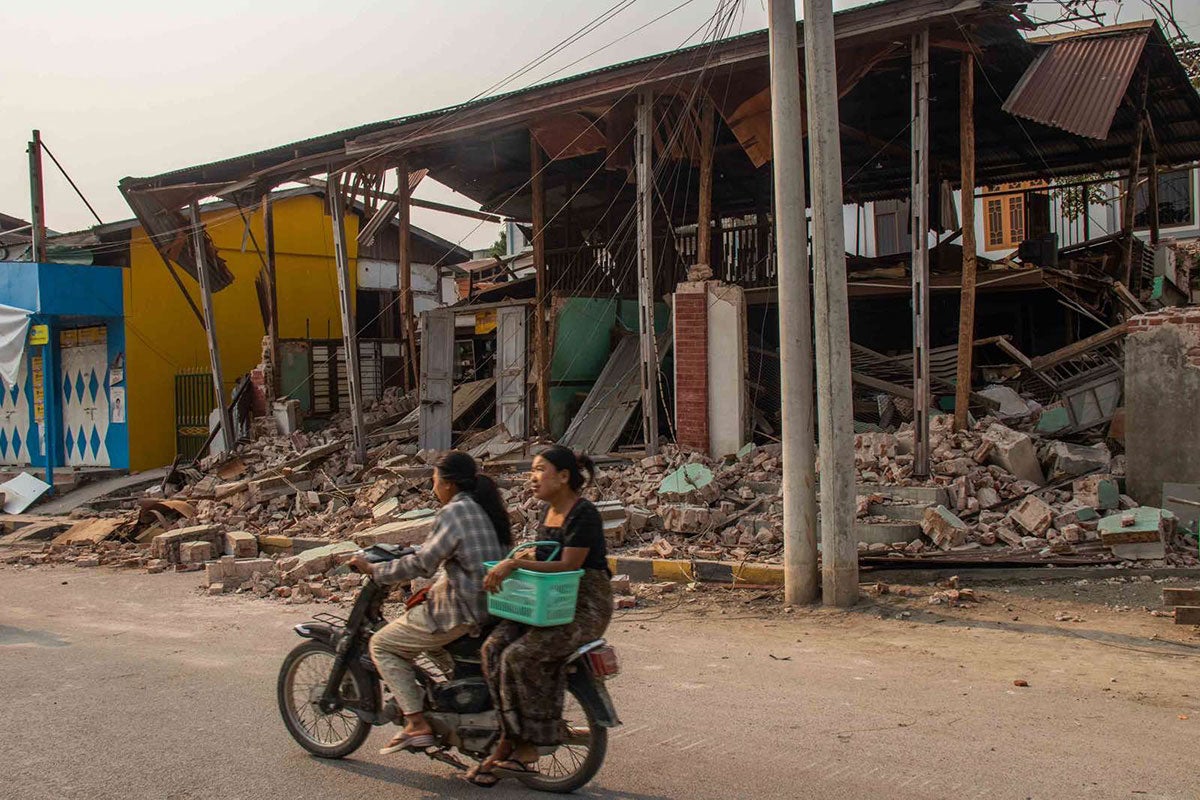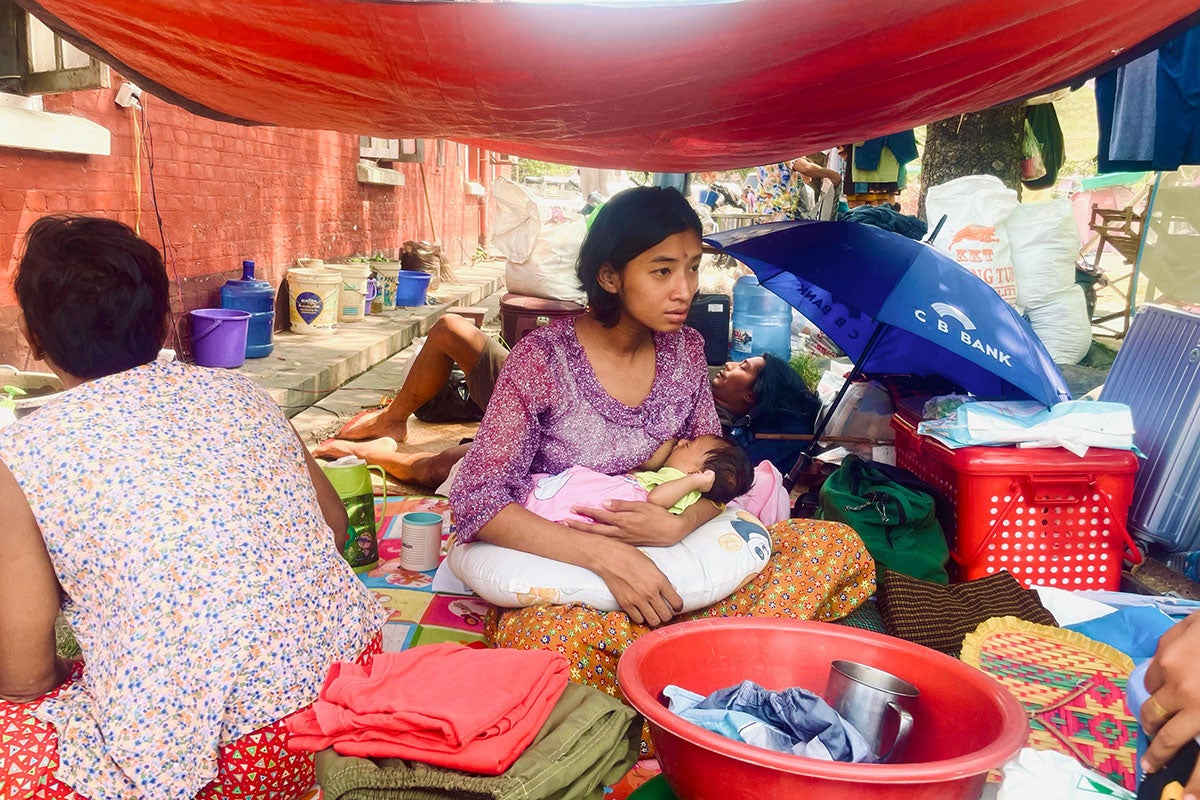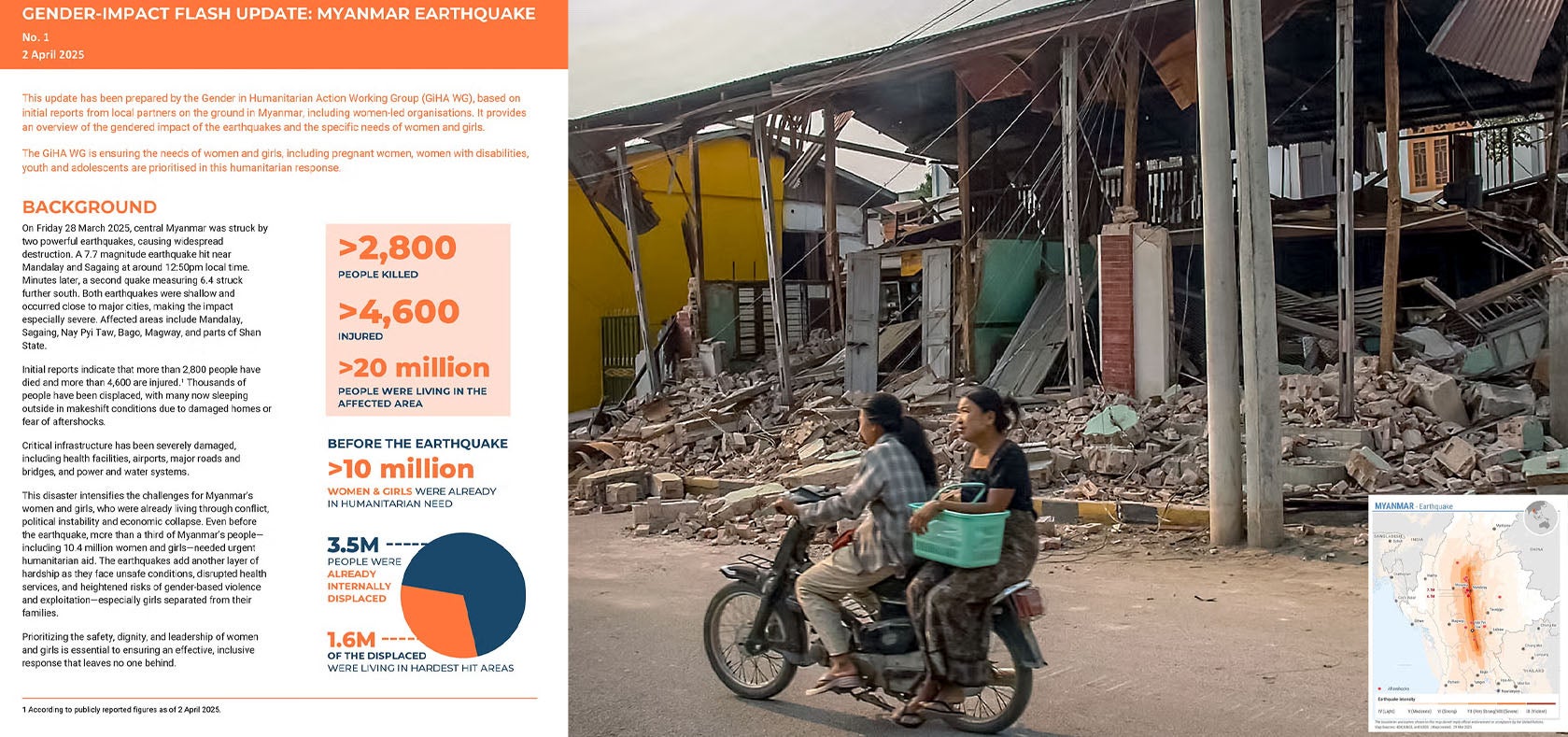Related
Myanmar Earthquake 2025: What it means for women and girls
Date:
On 28 March 2025, Myanmar was struck by two powerful earthquakes, a 7.7 magnitude quake near Mandalay and Sagaing, followed by a 6.4 magnitude quake further south. With over 2,800 people killed, 4,600 injured, and millions displaced, the humanitarian crisis is deepening. Women and girls, already vulnerable due to ongoing conflict and economic instability, face heightened risks and unique challenges in the aftermath.

Led by UN Women and UNFPA, the Gender in Humanitarian Working Group has worked with local partners in Myanmar, including women-led organizations, to report on the gendered consequences of the disaster.
UN Women is working with local women’s organizations to assess their needs, ensuring their voices are heard, and will soon start working with women to distribute urgently needed aid.
Which areas were most affected by the earthquake?
The 7.7 magnitude earthquake struck nea Mandalay and Sagaing, causing significant damage in central Myanmar and affecting neighbouring countries, including Thailand. Minutes later, the second quake at 6.4 magnitude, struck further south. Both earthquakes severely impacted major cities across Myanmar and affected areas include Mandalay, Sagaing, Nay Pyi Taw, Bago, Magway, and parts of Shan State.
Prior to the earthquake, 3.5 million people were already internally displaced in Myanmar because of ongoing political and economic instability, and 1.6 million of them were living in the hardest hit areas.

How has the earthquake impacted women and girls in Myanmar?
With thousands reported dead or injured, and critical infrastructure damaged, including health facilities, airports, major roads and bridges, and electricity and water systems down, the latest disaster has intensified the challenges for Myanmar’s women and girls.
Even before the earthquake, more than a third of Myanmar’s people— including 10.4 million women and girls—needed urgent humanitarian aid.
Recap of at what women and girls are reporting after the Myanmar earthquake:
1. Women and girls face increased risk of gender-based violence
With homes and infrastructure destroyed, women and girls are in overcrowded, makeshift shelters where they lack privacy and security. In many cases, they are staying outside in tents or with only blankets or sheets to separate spaces, and with limited lighting. Without access to gender-based violence services, survivors cannot get the help they need.
2. Family separation and children at risk
Children separated from families and caregivers and living in overcrowded shelters face increased risks of violence, trafficking, and unsafe migration. The risks are particularly heightened for girls, who may experience sexual violence or be forced into early marriages.
3. Disrupted healthcare has deadly consequences for women’s reproductive health
Many hospitals and health facilities have been damaged or destroyed, and the ones that remain standing are overwhelmed. Due to damaged roads and fuel shortages, women are finding it harder to access services. For women and girls, this translates to dwindling access to care for survivors of gender-based violence, or for safe childbirth and maternal health.
4. Lack of clean water, sanitation, and hygiene
Women and girls report insufficient and unsafe toilets and bathing spaces, making it difficult to maintain hygiene, especially during menstruation, pregnancy and post birth. In one temporary camp, the members of the Gender in Humanitarian Action Working Group observed only 14 toilets available for 1,200 people. There is also risk of diseases from contaminated water sources, as electric pumps are not working.
5. Women and girls are at increased risk of hunger and malnutrition
Food is becoming scarce and there are very few functioning markets. As prices are expected to rise and since women and girls are often responsible for feeding and caring for their families, they are at risk of getting less food and lower quality nutrition. Women-headed households struggle to access emergency relief and financial assistance and need income sources to cope with the disaster.
6. Mental health impact
Almost everyone affected by a humanitarian crisis experiences psychological distress. Around 1 in 5 people will go on to develop long term mental health conditions, yet only 2 per cent get the care they need. The mental health impact of the earthquake on Myanmar’s women and adolescent girls is profound, as they struggle with the trauma of losing homes, loved ones, while scrambling to survive and care for those who remain. The fresh trauma comes on top of the stress caused by the prolonged conflict and economic instability in the country.
Five urgent actions for supporting women and girls in Myanmar now
Women and girls form half of the affected population and must be an integral part of the humanitarian response. Learn more on how UN Women is prioritizing the safety, dignity, and leadership of women and girls in Myanmar.
- Gender-sensitive assessments: When disasters strike, governments, UN agencies and local partners assess the needs of the affected population. UN Women is working with partners on the ground to make sure women from the crisis-affected communities are involved in these assessments at the onset to understand and respond to their specific needs.
- Safe shelters and gender-based violence services: UN Women is advocating with partners to ensure women and girls have access to shelters with gender-segregated spaces, lighting, and security, as well as access to menstrual hygiene kits and services for survivors of gender-based violence.
- Restoring access to healthcare, including reproductive and mental health needs: There is an urgent need to prioritize life-saving sexual and reproductive health services for women and girls, including maternal care, through mobile health units.
- Ensuring food security and cash assistance: Women need emergency cash assistance and recovery programmes designed for them—especially those heading households, caring for others, or living with disabilities. They also need food aid and nutritious options for those pregnant and breastfeeding.
- Supporting local women-led organizations: Local women-led organizations with deep community ties, understanding and reach, play a vital role as frontline responders. They urgently need direct and flexible funding.
![[Myanmar donation]](/sites/default/files/2025-04/hq-donation-WF11012989%2020250331-960px.jpg?t=1743738180)
